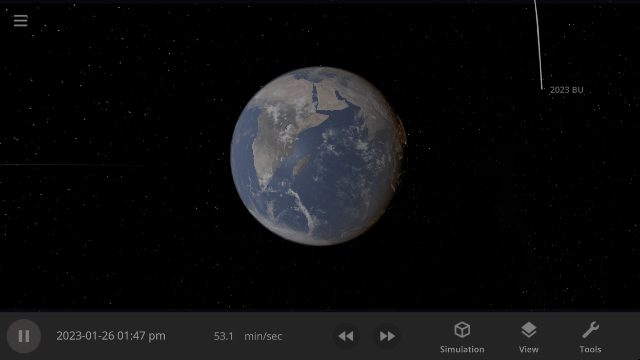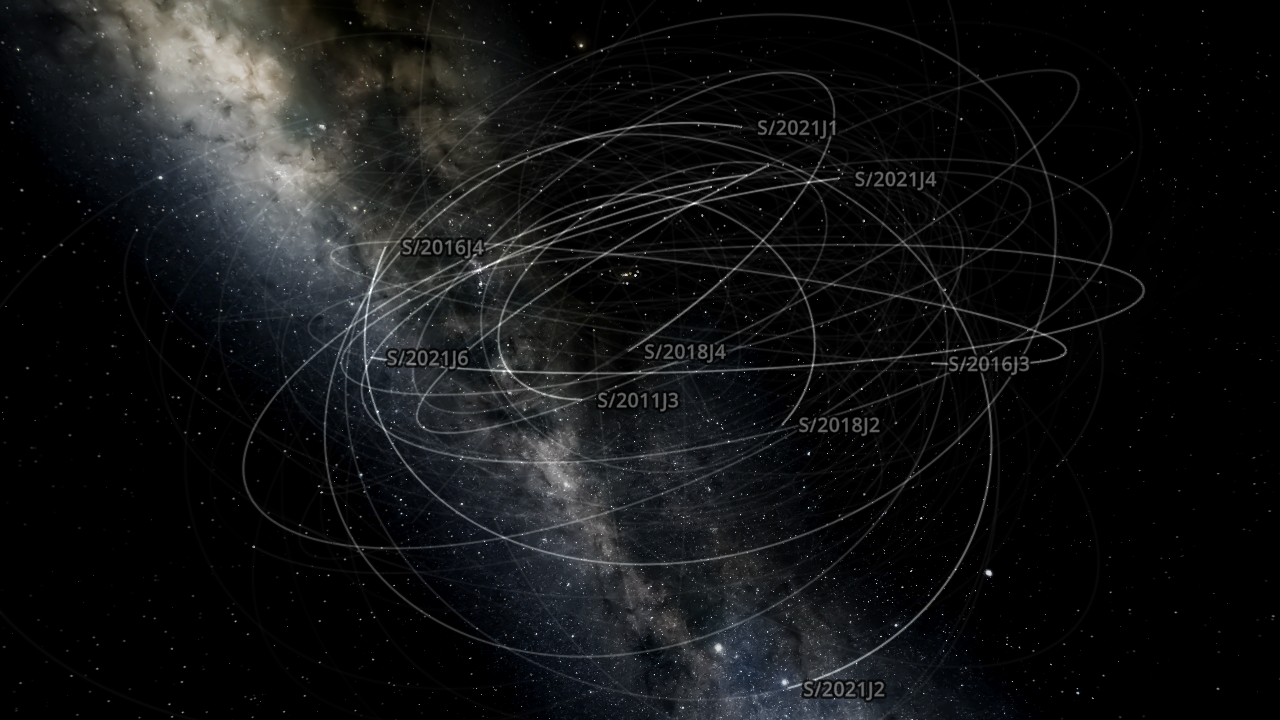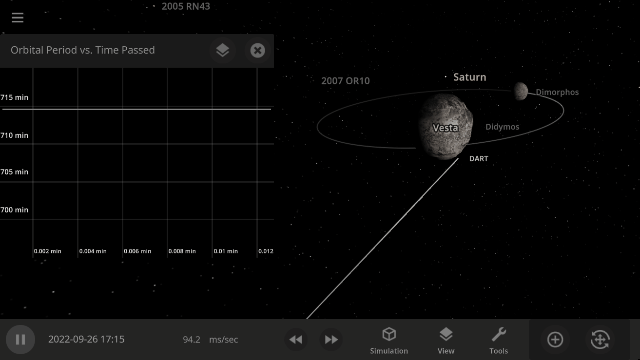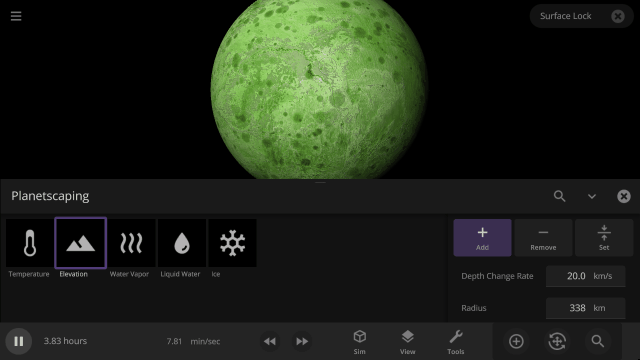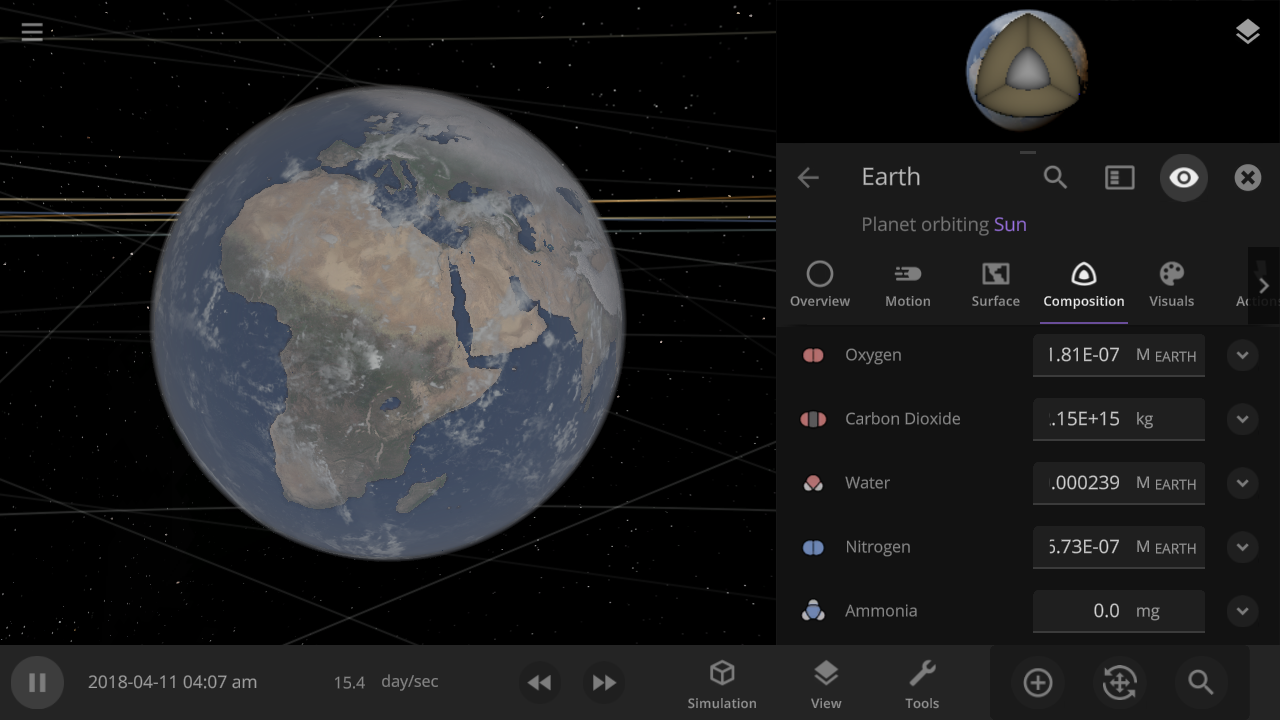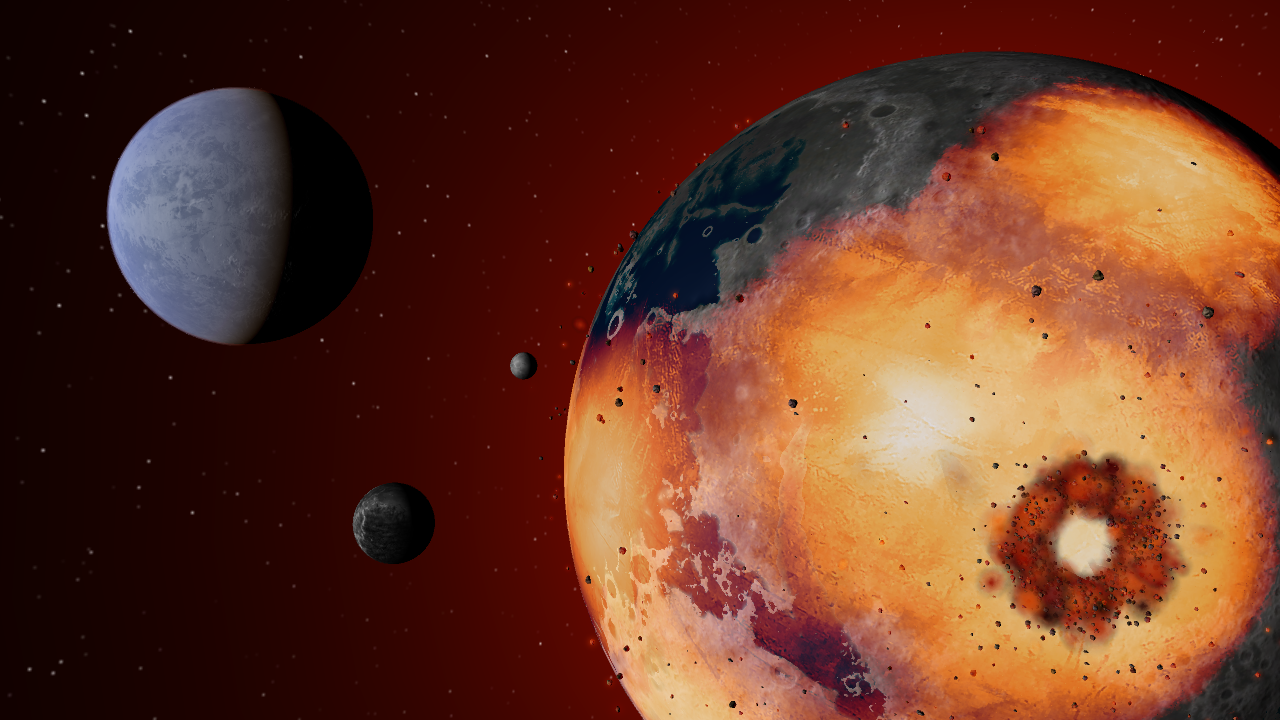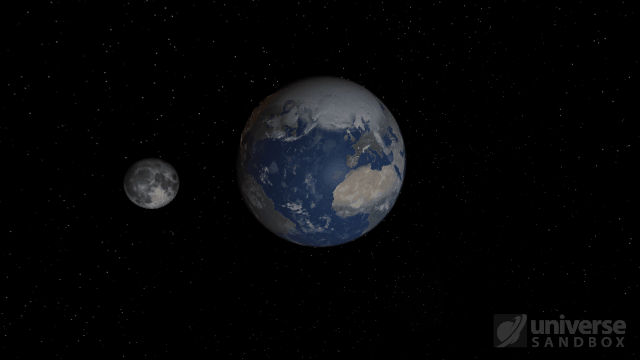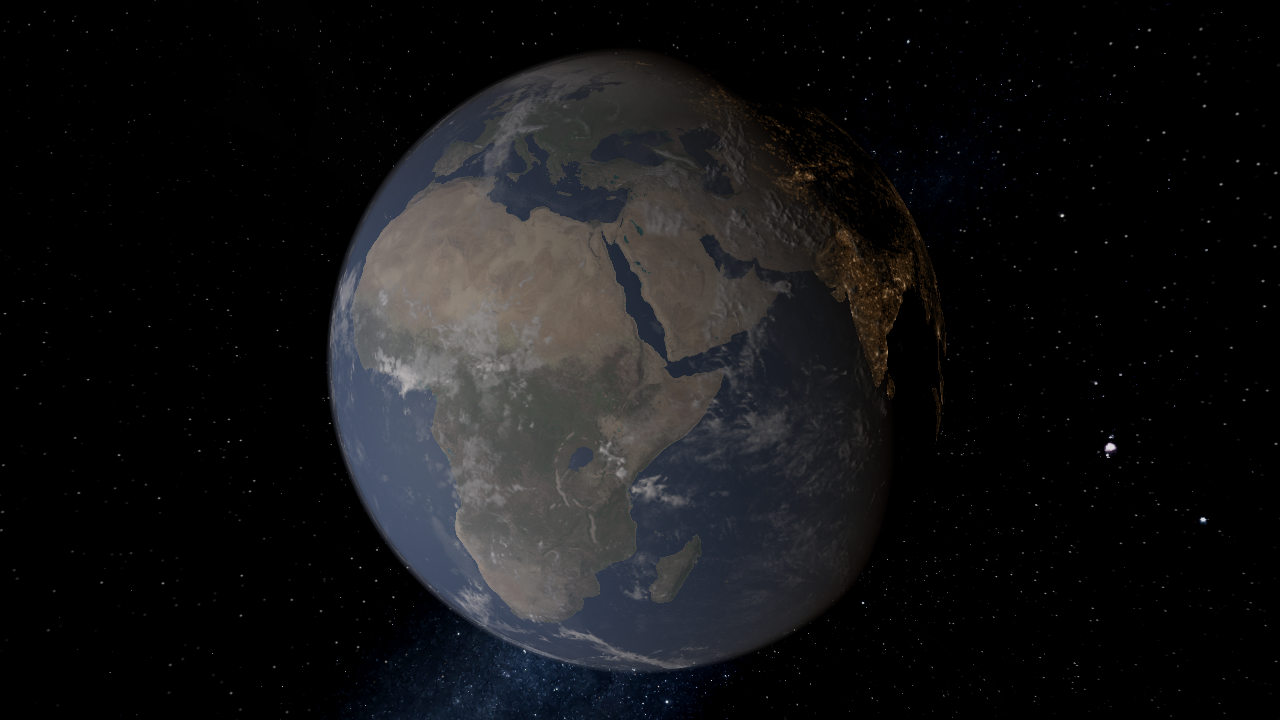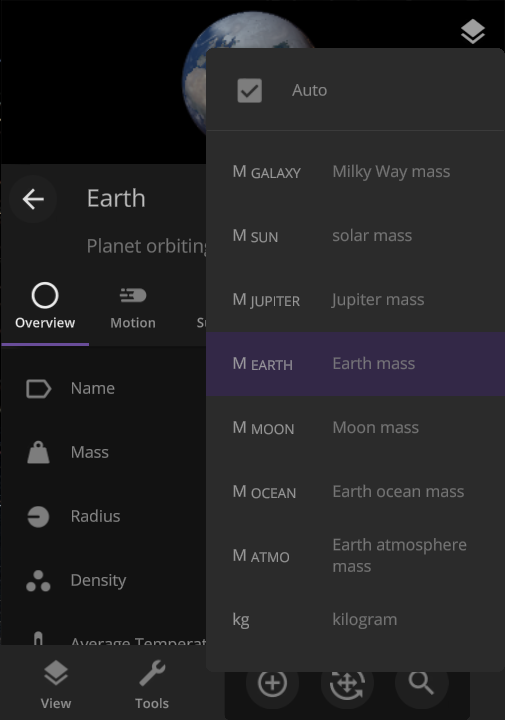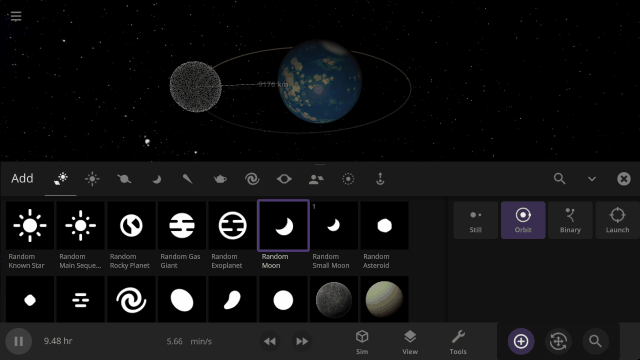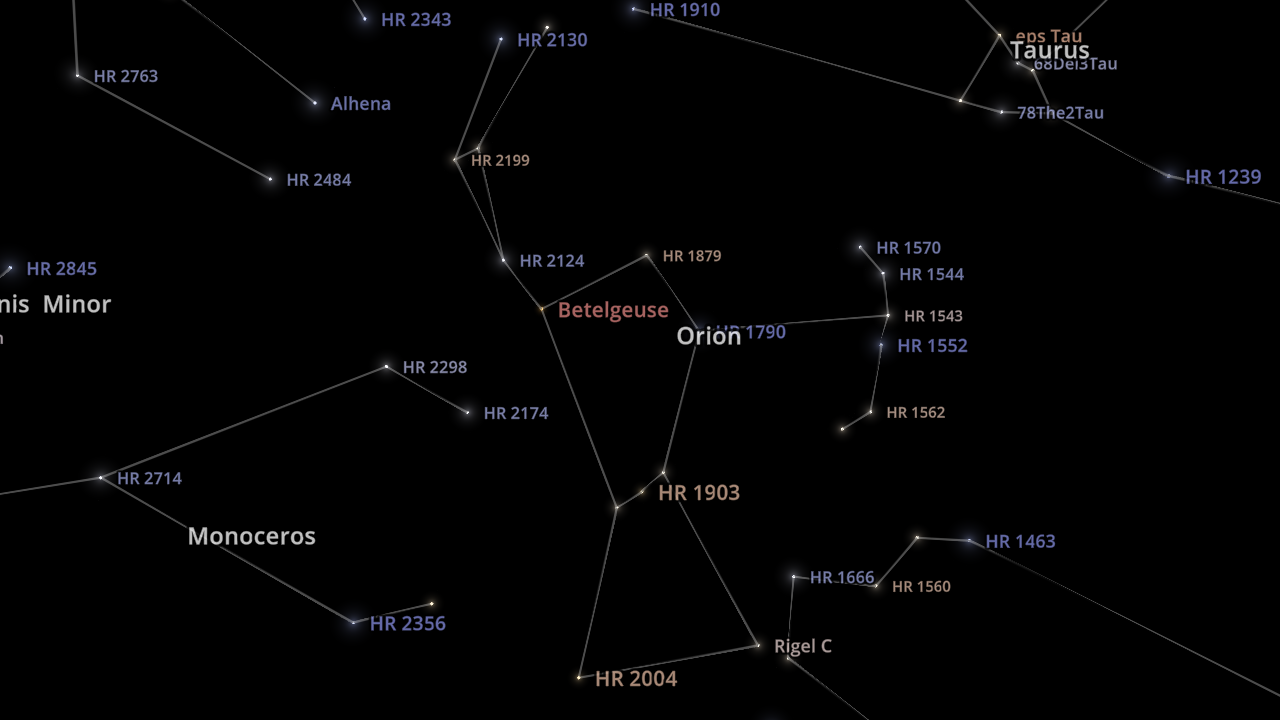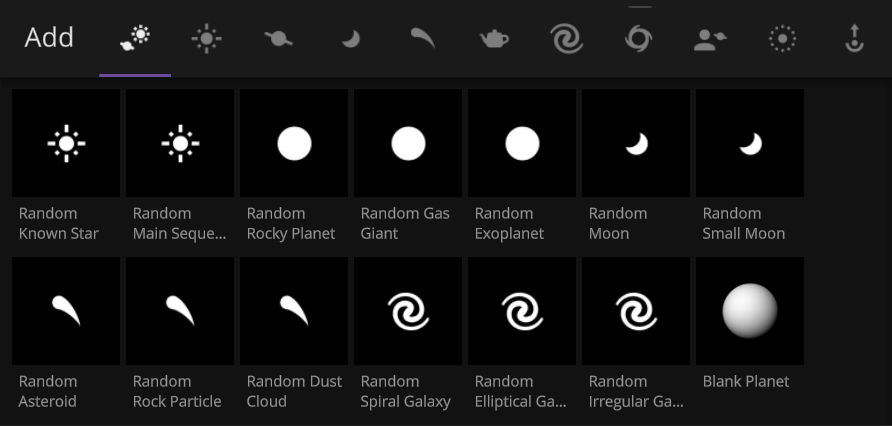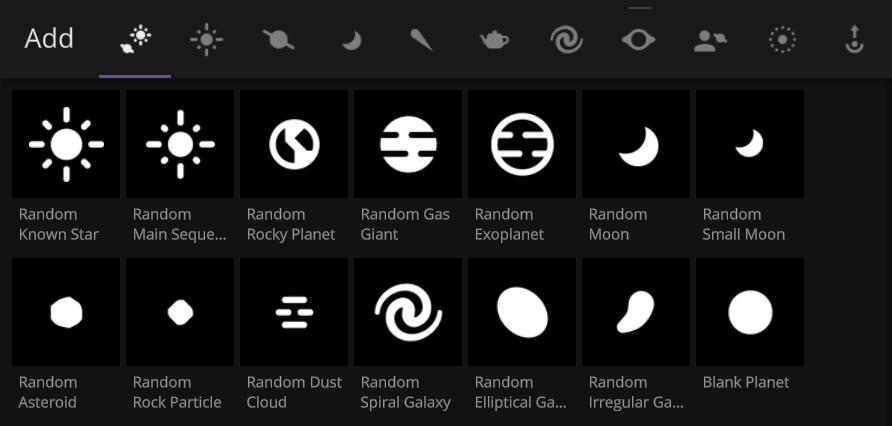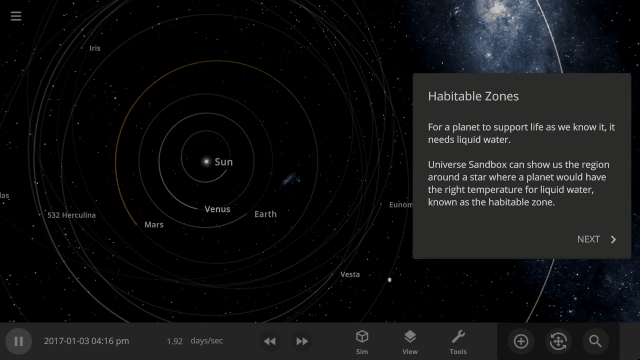
Mar 31, 2023
Universe Sandbox - bshapiroalbert

The Milky Way galaxy with a trail for every nebula in the galaxy using our upcoming physics architecture improvements. Currently, trails are only shown for some nebulae due to performance limitations. The colors show how many times the orbit of a nebula must be computed to maintain physical accuracy. Blue means fewer computations, while red means more.
We're working to give you more power to understand and control the complex phenomena of the universe. Our roadmap for 2023 includes simulating the lakes of liquid methane on Titan, hot planets emitting light, and realistically colliding spacecraft and bananas. But before we dive in, let's recap some accomplishments from last year.
Highlights From 2022
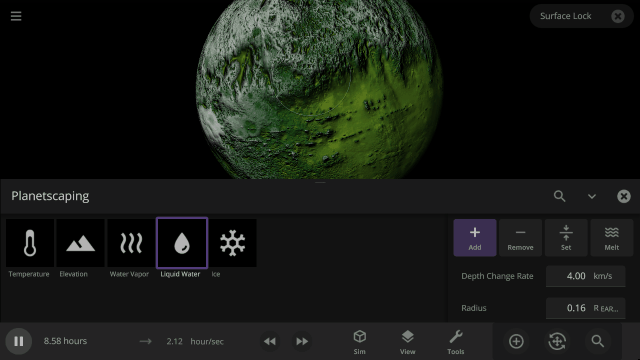
Demonstrating highlights from 2022, including the Force Spin tool, Settle Water button, and Auto Simulation Speed.
In 2022, we put out 9 updates for Universe Sandbox. These included many new features, but some of our favorites are
- Spinning up planets so fast they break apart using the new Force Spin tool
- Exploring constellations for 10 different cultures
- Customizing the look and topography of planets and moons with a library of realistic color and height maps
- Fundamental improvements to our planetary collision system
So What’s the Plan for 2023?
- Add more materials for constructing & simulating planets & atmospheres
- Overhaul our under-the-hood physics architecture to improve accuracy and performance
- Simulate light emission from hot planets
- Continue work on bringing Universe Sandbox to phones and tablets
- Improve our development tools to identify issues quickly and provide a more bug-free experience
More Materials & Composition Simulation

Titan with realistic lakes of liquid methane. Titan’s properties include the amount of methane and the percentage in each phase (solid, liquid, and gas). Material colors are manually adjusted to help see the lakes. This feature and interface are a work in progress.
We’re expanding the number of materials in Universe Sandbox you can use to simulate, construct, and terraform planets and atmospheres realistically. For example, new materials like methane will allow us to fully simulate lakes of liquid methane on Titan. We’re also adding advanced simulation to compute planet radii based on the pressure and temperature of each material in the planet’s composition. Ever wonder how big the Moon would be if it were made entirely of oxygen? Soon you’ll be able to find out.
- A (Multi) Material World
- Planet radii and atmospheres will be realistically simulated based on the mass and phase (solid, liquid, and gas) of each material in their composition.
- Simulation of an atmosphere’s heating (the greenhouse effect), color, and opacity, including Venus-like atmospheres, will be based on their material composition.
- Designing the properties, data views, and tools for you to construct atmospheres, build and terraform planets, and track these materials is a crucial part of our development process.
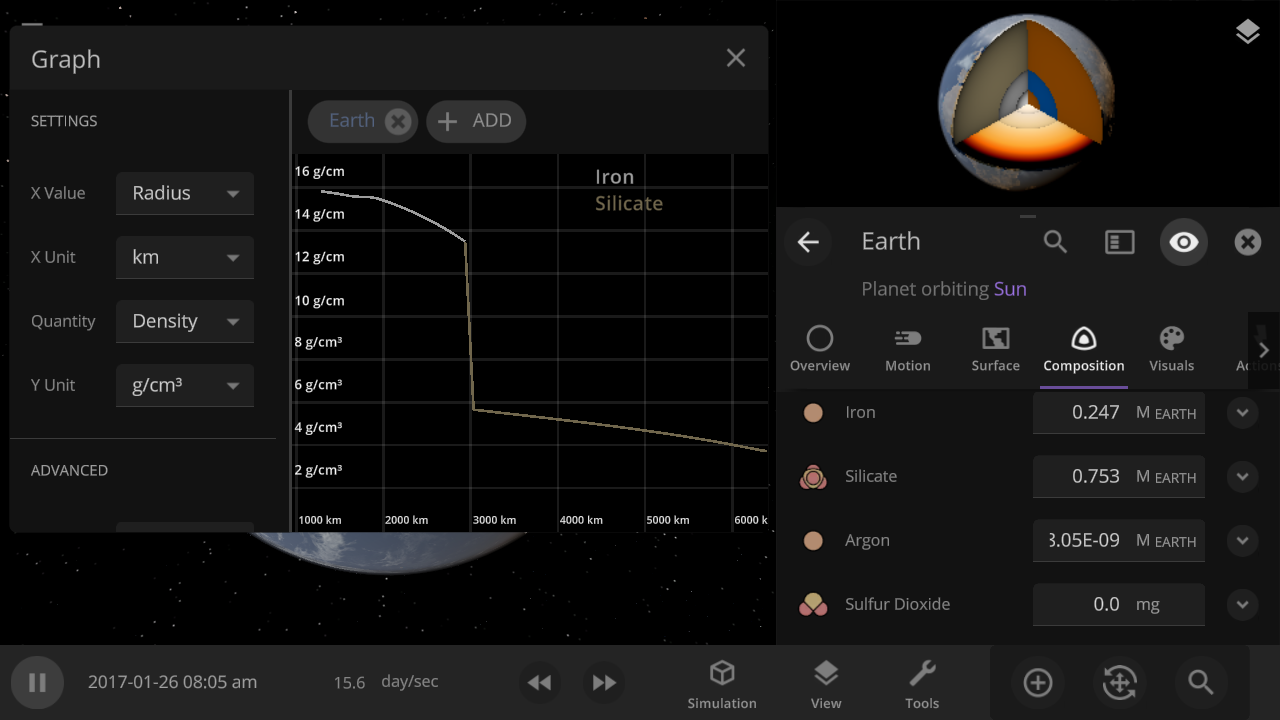
This graph shows the calculated density of the materials of Earth based on their depth. You can see the density of Earth increases as you move towards its core. The cut-away view of Earth shows the individual materials, temperature, and phase of each material from the inside out. This feature and interface are a work in progress. - Planet radii and atmospheres will be realistically simulated based on the mass and phase (solid, liquid, and gas) of each material in their composition.
- Physics-based Phases
- The phase of each material in a planet’s composition will be realistically determined based on its pressure and temperature. Make a planet entirely out of water and see the phases from the inside out (our current model says it would be 100% liquid inside).
- Material phase models are based on geological and astrophysical measurements and research.
- Planet radii will then be calculated based on the phase and density of each material that makes up a planet’s composition. If you change the composition, the radius will change with it.

Liquid materials added to the surface of a planet with the Planetscaping tool will blend over time. Artificial coloring is used here to help differentiate materials. This feature and interface are a work in progress. - The phase of each material in a planet’s composition will be realistically determined based on its pressure and temperature. Make a planet entirely out of water and see the phases from the inside out (our current model says it would be 100% liquid inside).
- Tracking Materials
- Materials will have customizable colors based on their physical properties that will blend on the surface of objects. Watch oceans of methane mix with oceans of oxygen in real time.
Physics Fundamentals

While many moons orbiting Earth and colliding are beautiful, the more objects in a simulation, the more computationally demanding it is.
Our project to add everyday object collisions, like throwing a banana at a car, led us to first rewrite our physics architecture. Realistically smashing satellites together is part of continuous efforts to improve the realism and performance of Universe Sandbox.
- New Physics Architecture
- Overhauling our custom N-body (gravity) simulation will improve gravity-related accuracy, stability, and performance. Tight orbits like the Hubble Space Telescope around Earth should be stable at simulation speeds as high as a month per second (instead of a few days).
- These updates are the foundation for future physics improvements, like spaceships.
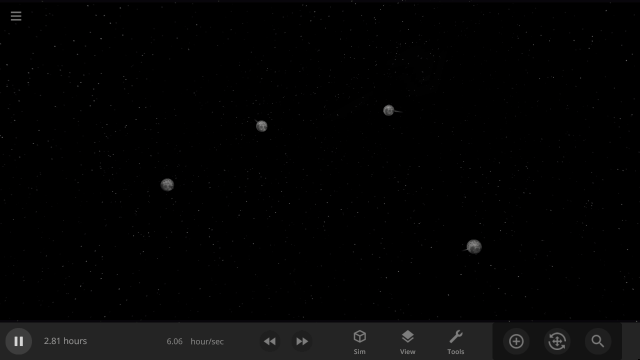
Before - Our current gravity simulation has small inaccuracies, so the trails of these moons don't show a fish.

After - Improvements to our gravity simulation allow these moons to orbit with trails that clearly show a fish.
- Overhauling our custom N-body (gravity) simulation will improve gravity-related accuracy, stability, and performance. Tight orbits like the Hubble Space Telescope around Earth should be stable at simulation speeds as high as a month per second (instead of a few days).
- Everyday Object Collisions
- Currently, when objects collide, they're treated as spheres. We're working on adding new physics so that everyday objects, simple shapes like dice and pyramids, but also complex shapes like sledgehammers and spacecraft, will collide according to their unique forms. This is often known as rigid body collision physics.
- Improved Planetary Collisions
- We’re researching methods to allow objects to stretch and deform, like two fluids mixing, during collisions, to improve upon the sphere absorbing method we currently use. Stay tuned for a status update later this year.
- Meteors & Shooting Stars
- To simulate meteors and shooting stars, we’re working on allowing objects to burn up while traveling through a planet’s atmosphere. We’re exploring ways of applying this drag force to objects passing through gas clouds and liquids too. Currently, atmospheres have no effect on objects as they pass through them.

A meteor burns up as it flies through Earth’s atmosphere. Adding atmospheric drag is a work in progress. - Advanced Game Engine Features
- As an ongoing project to optimize our simulation, we’re transitioning to the Data-Oriented Technology Stack (DOTS) from Unity, the game engine we use to build Universe Sandbox. We’re excited about the expected performance gains.
Lights in Space

As moons collide, they get hot enough to glow and emit light on the surrounding moons. Non-stellar objects emitting light is a work in progress.
We want to light up the universe - by allowing hot planets and moons to emit light. We’re also planning a massive graphics overhaul that will change how you see the Universe (Sandbox).
- Light ‘em Up
- Light - it’s not just for stars anymore. Hot planets will emit light based on their temperature so you can light up your simulation by setting Earth to 1000 °C.
- This lighting system will eventually allow you to place and customize lights anywhere in the simulation so you can illuminate your universe without stars.
- Light - it’s not just for stars anymore. Hot planets will emit light based on their temperature so you can light up your simulation by setting Earth to 1000 °C.
- Untitled Graphics Overhaul
- We don’t want to say too much yet, but we’re working on a massive update to our graphics system that the whole team is very excited about.
Universe Sandbox on Tablets & Phones

The first step of the Welcome to Universe Sandbox guide playing on a smartphone in portrait mode. Universe Sandbox on phones and tablets is a work in progress and is still being developed.
We’re stepping up our development for Universe Sandbox on mobile devices (for iOS and Android) after some delays last year. You can read about our plans in our first Mobile DevLog, and be on the lookout for more updates in the future.
- Small Screen Experience
- The primary obstacle in mobile development is adapting our interface that works well on a large screen to work on a small touch screen (like a phone).
- We’re building a system to intelligently resize, hide, and reveal panels as needed. Our goal is to reduce the need for you to spend time managing the user interface so you can focus on bending the simulation to your will.
- The primary obstacle in mobile development is adapting our interface that works well on a large screen to work on a small touch screen (like a phone).
- All of the Above
- Universe Sandbox on mobile is built from the same codebase as the desktop version and will have the same features.
- Performance is also critical, and we’re working to make Universe Sandbox run smoothly on mobile devices no matter the simulation.
- Universe Sandbox on mobile is built from the same codebase as the desktop version and will have the same features.
Enhancing Our Developer Toolkit
An initial selection of scenes we’re considering for our new in-game Universe Sandbox trailer. Our new trailer is a work in progress.
We’re creating new internal tools to make developing and releasing updates of Universe Sandbox faster. These include systems to analyze your feedback and automate testing for bugs and issues.
- Testing 1, 2, 3
- Creating tests that run automatically to check our collision physics, simulation performance, and more will help us catch issues before they’re released. These tests record data and images we can use to find bugs more easily.
- Tracking Feedback
- Your in-game feedback and issue reports help us improve Universe Sandbox, and there’s a lot to review. We’re transitioning to a new system to sort and analyze your feedback more efficiently.
- Building the Sandbox
- We’ve revamped our automated build system. This system creates a new version of Universe Sandbox in the cloud every time a change is made by one of our team members.
- This automation saves each of us 10-15 minutes each time we want to review a change.
- With a single button, we can also release new updates to all digital stores that sell Universe Sandbox. This process used to take many hours and involved dozens of manual steps, so this makes it possible to release more updates faster.
- This new system easily makes versions of Universe Sandbox we can test on phones and tablets (iOS and Android) too.
- We’ve revamped our automated build system. This system creates a new version of Universe Sandbox in the cloud every time a change is made by one of our team members.
- New Trailer
- We’re producing a new Universe Sandbox trailer fabricated entirely in-game. We’ll be able to capture it with a single button press, making it easier to iterate on the trailer over time to show off the latest features and improvements.
- You will be able to play this new trailer inside Universe Sandbox, breaking out of it to experiment or explore every shot and simulation.
- We’re producing a new Universe Sandbox trailer fabricated entirely in-game. We’ll be able to capture it with a single button press, making it easier to iterate on the trailer over time to show off the latest features and improvements.
And Beyond

A habitable planet with vegetation that dies off after an asteroid impact. Vegetation response to temperature is already implemented, but in the future, additional factors beyond collisions will impact vegetation habitability.
We’re always thinking about the future of Universe Sandbox. Our longer-term goals include gamepad support, life simulation, and more planet customization options. These are still in early development, and we don’t have a timeline for their release (because software development is hard, and not even our astrophysicists can predict all of the complexities of simulating the universe).
- Custom Textures
- We want to give you more control over the appearance of your planet. Satisfy your world-building desires by creating a planet using custom maps or images, like a picture of your dog.
- Gamepad Support
- What could be better than playing Universe Sandbox from the comfort of your couch? We’re working on adding gamepad support for more ways to control your universe. This will improve our Steam Deck support and has the potential to support other gamepad-based systems in the future.
- Life Simulation
- Our expanded materials improvement is the cornerstone of our plans for life simulation. Once Universe Sandbox includes the essentials for life, like oxygen and carbon dioxide, we will be able to explore simulating simple life that will spread across the surface of a planet.








